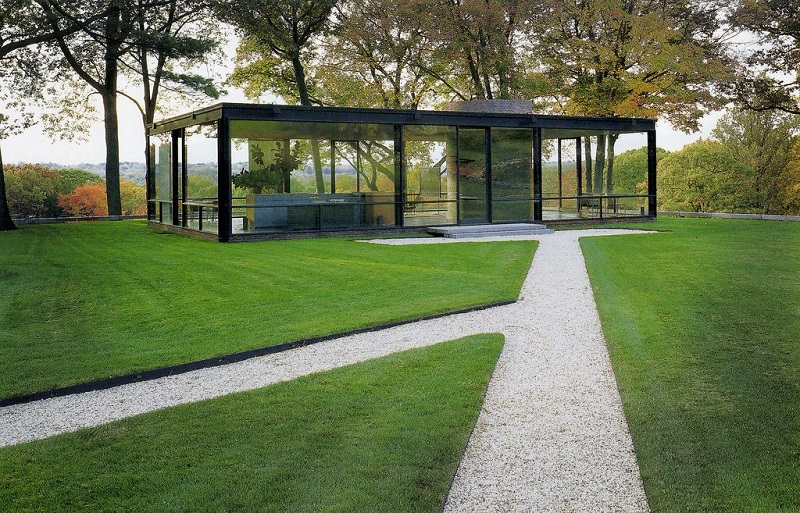Morven Speaker Series Takes Visitors To Landmark Houses from the Last Century
MORVEN GOES MODERN: Mid-century, that is. Philip Johnson’s famous Glass House in New Canaan, Conn., is among four featured in the annual upcoming “Grand Homes & Gardens” series. (Library of Congress Public Domain Image Collection)
By Anne Levin
Over the past five years, staff at Morven Museum & Garden who plan the annual Grand Homes & Gardens lecture series have surveyed audiences about what subjects, and eras, they might like to learn about in the future. More often than not, requests are for the mid-century modern period of architecture and design.
Morven has responded. This year’s series, starting February 26 at 6:30 p.m., is “The Quality of Doing: Mid-Century Modern Grand Homes & Gardens.” Led by four scholars, three of whom will be in person and one via Zoom (all lectures are offered in hybrid format), the series takes viewers from Philip Johnson’s iconic Glass House in Connecticut to the experimental Case Study Houses in southern California.
In between are Mies van der Rohe’s Edith Farnsworth House in Plano, IL, and Louis Kahn’s Toby and Steven Korman House in Fort Washington, Pa.
“It’s exciting to respond to what people want to see us do,” said Greer Luce, Morven’s curator of education and public programs and the series coordinator. “It’s also a good chance for us to connect to that period in our history, which isn’t often a focus.”
First on the schedule is the property closest to Princeton. Philadelphia-based architect Louis Kahn completed the Toby and Steven Korman House just a few months before he died in 1973. Known for his great institutional and monumental buildings throughout the world, Kahn also designed many different kinds of dwellings. Speaking about him on February 26 is William Whitaker, director and chief curator of the architectural archives at the University of Pennsylvania’s Stuart Weitzman School of Design; he is also the author of The Houses of Louis Kahn.
Next on March 5 is “Architecting Nature: Philip Johnson, David Whitney and the Evolution of the Glass House Estate, 1946-2024.” Johnson designed the house in a fairly traditional layout, except for one thing — it has no walls. The house is described as being best understood as a pavilion for viewing the surrounding landscape. It is considered iconic because of its innovative use of materials and integration into the landscape. Leading the discussion will be Maureen Cassidy Geiger, art historian and author of The Philip Johnson Glass House: An Architect in the Garden.
“Reclaiming the Edith Farnsworth House” is March 13, with Nora Wendl, associate professor of architecture at the University of New Mexico and author of Almost Nothing: Reclaiming Edith Farnsworth as lecturer. Considered one of Mies van der Rohe’s most significant works, the house “embodies a certain aesthetic culmination in his experiment with this building type,” according to the website for the house. “Second, the house is perhaps the fullest expression of modernist ideals that had begun in Europe, but which were consummated in Plano, Illinois.”
The final program on March 20 is “Celebrating the Experimental: The Case Study Houses,” led by art historian and curator Elizabeth A.T. Smith, who wrote Case Study Houses: 1945-1966. Arts & Architecture magazine spearheaded the program by commissioning eight nationally known architects to create contemporary single-family homes within a specified budget.
“One of the things I’m most excited about is the speakers themselves,” said Luce. “We have a great lineup of people who are at the top of their game in the history of architecture field. Each has written books about these homes, and they come from different perspectives — some from history, and some considering landscape and gardens.”
Morven began the series in 2019 as a kind of “armchair travel” opportunity during the cold months of the year. The series took off a year later, during the COVID-19 pandemic, when it was offered online. It continues in a hybrid format today.
A key part of the experience is the refreshments served at each gathering. “They are tailored to the time period being discussed, or a person involved. It might be an architect’s favorite cocktail, or something like that. It makes you feel like you are part of that time,” said Greer.
The series continues to be the most popular lecture program that Morven offers.
“I think people love the opportunity to hear about these places that might be far away, or bring them somewhere interesting in the middle of winter,” Luce said. “And I feel we’ve done a pretty good job to bring in speakers who tell really great stories about these places. They’re telling you about the people. You’re not just hearing someone drone on.”
Lectures take place in Morven’s Stockton Education Center, on the campus at 55 Stockton Street. For tickets and more information, visit morven.org.


